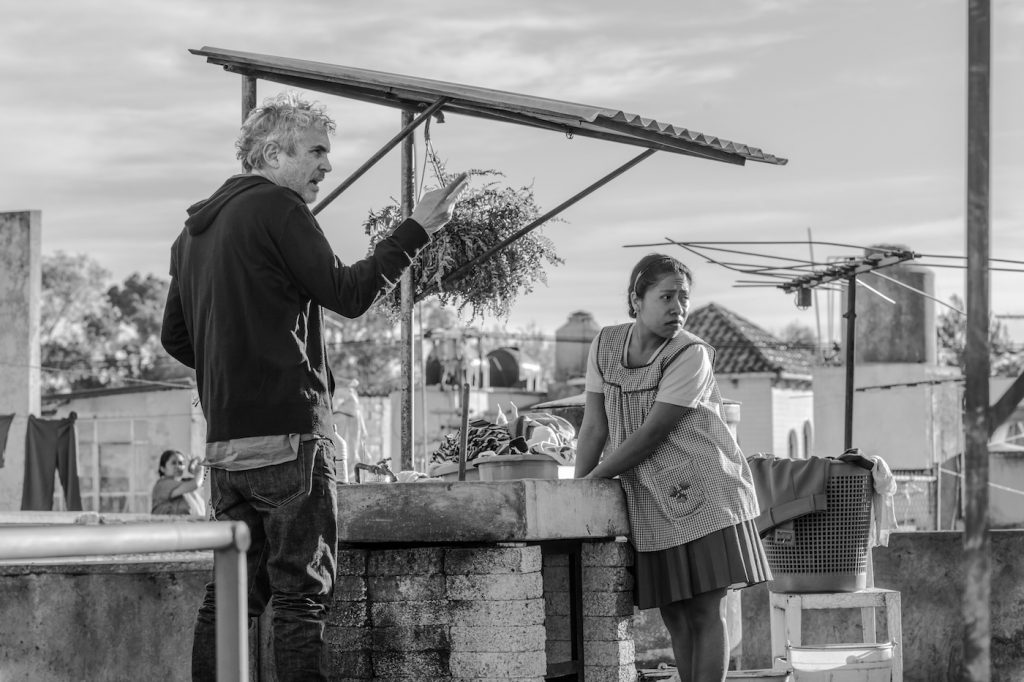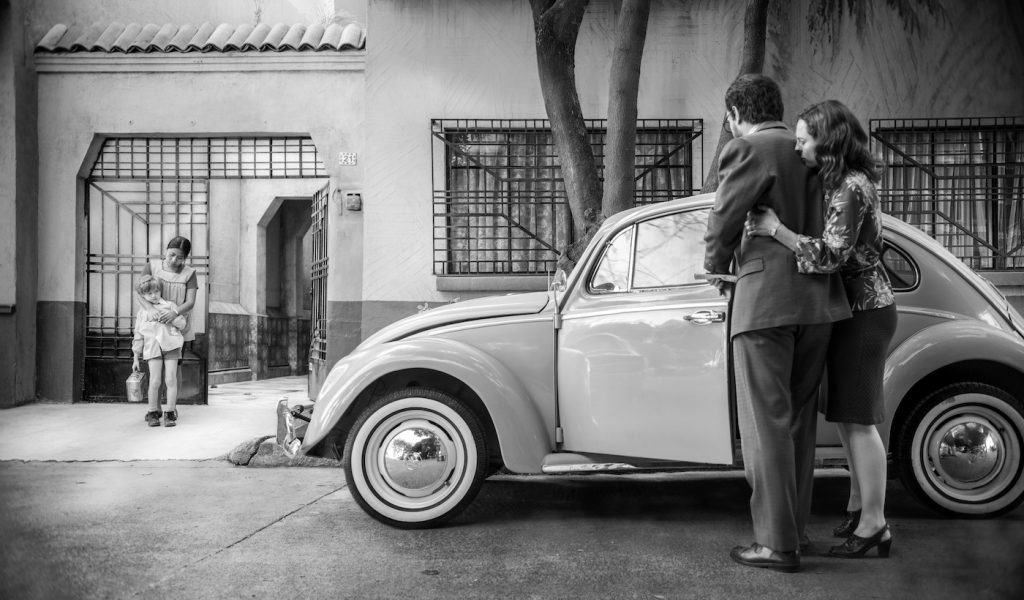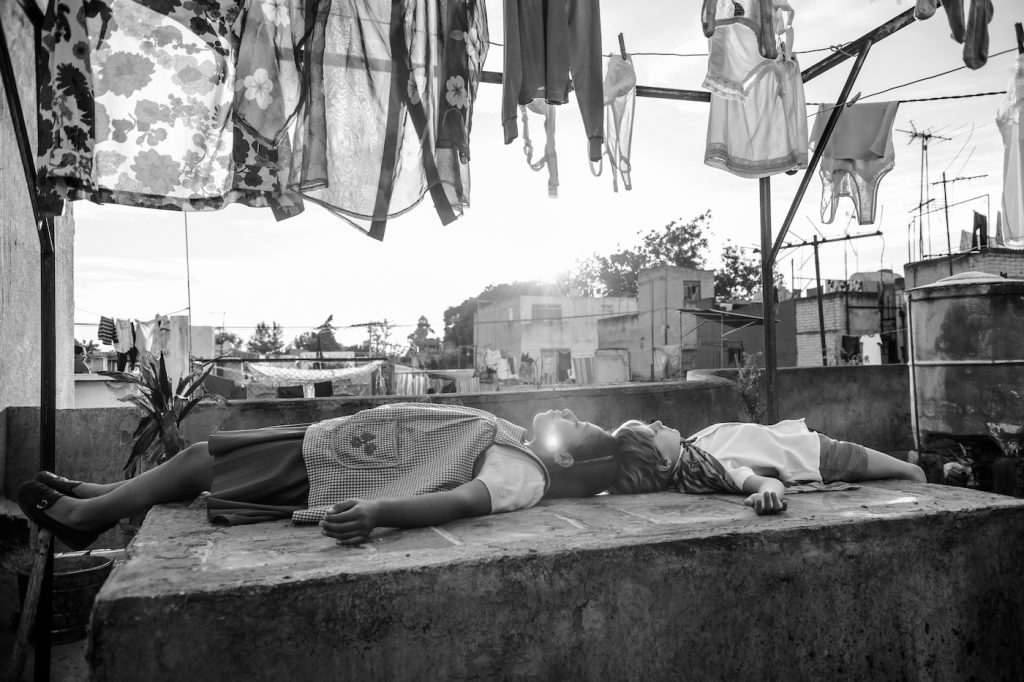Roma’s Oscar-Nominated Sound Team on Making a Music-Free Film
Water sloshes in a rooftop laundry tub, a faucet runs, and the strains of a tinny radio shift to the quiet chatter of a family at home. Alfonso Caurón’s Roma depicts the daily life of Cleo (Yalitza Aparicio), an indigenous maid in a white, middle-class Mexico City household, an employee who gradually emerges as a seventh member of the family for whom she works. Cuarón punctuates her days, shepherding four children out of bed, clearing dishes, and retiring at night to her shared quarters, not with music but the sounds of his childhood, on which the film is based.
The result is unparalleled realism, not just in the black-and-white digital shots that pan across the comfortable Cuarón family home, the streets of Mexico City and the expansive nearby countryside, but the sounds one hears there, from the family dog’s woofs echoing in the private carpark to the chattering of a multi-generational Christmas gathering at the edge of a disputed forest, which later goes up in flames.
https://www.youtube.com/watch?v=fp_i7cnOgbQ&t=2s
“Sergio [Diaz] recorded and gathered sound effects for a year,” Skip Lievsay, who with Diaz comprises Roma’s Oscar-nominated sound editing team, tells me. Diaz, who used to live in Mexico City, started with authentic atmosphere—traffic, birds, environmental sounds—gradually collecting more specific sounds, like those of vehicles from the early 1970s, when Roma is set. The painstaking results are muted yet precise, seemingly designed to induce a sense of nostalgia, whether or not you yourself have ever eaten a sweet potato from the camote vendor or engaged the knife sharpener in this peaceful middle-class neighborhood, last week or fifty years ago.
“On Christmas Day, things are very quiet in Mexico City—the traffic is almost nonexistent, and you get these recordings of what this gigantic city sounds like, without [so many] cars and airplanes,” says Lievsay. “Sergio recorded all day long, in four different areas, so he had morning, noon, and night sounds in each area of the city.” Should you choose to close your eyes and merely listen to Roma, you will know what the weather is like, can estimate the time of day, and guess which family member Borras, the dog, is leaping and barking to greet.
I ask Lievsay and Craig Henighan, who with José Antonio García make up Roma’s Oscar-nominated sound mixing team, how these intricate but alien-to-me sounds can somehow induce nostalgia for Mexico in the early 1970s, despite the fact that I was born in New York in the mid-80s.

“Many people have told Skip and I that—that you really feel that time,” Henighan says. “I think it’s a testament to the sounds that Sergio found and recorded, and also the time we took to mix the film correctly, to make sure every single little thing felt correct.”
Creating the final film mix lasted ten weeks, where a typical mixing process, Lievsay estimates, takes two to five. This attention to detail—the sound team experimented with “cacophony,” then broke down their experiments and re-made them for numerous scenes—is best evidenced in an ordinary slice of family life played out in a hailstorm. While the children shout and fling pellets in the open-roofed carpark, the women of the house remain inside. As Cuarón’s camera cuts between the generations, so too does the intensity of pinging hailstones. “Everything is subtly moving to give you the impression of real life,” Henighan explains. “We had so many layers and kinds of hail—hail on windows, on the roof, on the street. We had to make all these layers work, so as the camera moved through the room and settled on mom, grandma, and Cleo on the couch, then came back around to the carpark and the children playing, we tracked all of those moves with the sound.”
The physical hail is also a testament to the exacting measures across the production. After Cuarón deemed the delivered hail too uniform, the production designer, Eugenio Caballero, suggested using glue sticks. “There was a period of a couple days on set when everyone was cutting up glue sticks and making hail,” says Lievsay. “It turns out you can feel plenty cozy inside, protected against a hailstorm that will never sting your forehead, if it feels in your ears that you are there.
At first, Cleo’s life is predictable, easily described by the sound of weather. She does laundry and waits at the table, deferring to the lady of the house, Señora Sofia (Marina de Tavira). With four children—Toño, Paco, Sofi, and Pepi—one might expect screaming and crashing, but they mostly get along. Their play punctuated by the pop pop pop of cap guns or the scratchy grinding of toy trains.
Soon, though, these placid days in the family home and the little noise that accompany them are riven by Señor Antonio (Fernando Grediaga), who leaves Sofia for a younger woman. The revelation occurs in about as noisy an environment as you’ll get in Roma: the street outside a cinema where Cleo has accompanied the children and their grandmother, Teresa. Antonio and his mistress suddenly race past, shrieking and laughing. But a grating sound earlier hinted that something was wrong—why else would Sofia determinedly scrape her husband’s massive sedan into a nonexistent lane between two trucks?

Meanwhile, Cleo’s romantic situation also worsens. She reveals to her martial arts-obsessed boyfriend, Fermin, that she’s pregnant. He leaves her in a movie theater. On the screen, two astronauts on screen tumbling absurdly through space. When she finds him at his martial arts camp in an open field, with the only sound wind whistling around his blathering guru, it’s clear that Fermin is gone for good.

Soft-spoken Cleo stays on with her employers. A few months on her water breaks while crib-shopping with Teresa. This occurs as riots between students, police, and the paramilitary group Los Halcones (of which Fermin is one) rage outside. Standstill traffic creates a cacophony of honking. These sounds rage outside as Cleo tries not to give birth in the back seat of the new family sedan. It’s intensely stressful.
Worse than the strains of labor set to a traffic jam is a day at the sea. This becomes a quiet and unexpected source of panic at the end of the movie. Sofi takes the children and Cleo to Veracruz, a holiday pretext for Antonio to clear out his things. She leaves Cleo, who can’t swim, at the beach, admonishing her older children to stay by the shoreline. They do not, and Cleo, her panic rising, sees them pulled into the waves.
It was a challenge “to get that sequence to feel natural, as Cleo gets in the water,” Henighan says. “Knowing she can’t swim and that she has to save these two children. To make these waves feel relentless and slowly build up. To slowly immerse the audience in the water.” Cleo moves through the water in real time, which is to say, agonizingly. She plunges into the ocean as waves swell around her head. This is a sound which Henighan and Diaz combined years of recordings to achieve.
https://www.youtube.com/watch?v=FLTyL1nEX4s
Roma includes many of Cuarón’s signature elements. Cleo’s interminable, dangerous march into the ocean to retrieve the drowning kids, for instance. This reminiscent of Kee and Theo’s long unbroken walk clutching a newborn through a battlefield in Children of Men. Roma might be a far quieter film, but the peace represents no lack of sound. The sounds are decisive, created by both expertise and immense thought and planning. The mundane significant and the background of life, whether it’s morning birds or urgent footfalls on a hospital floor, ever-present. “Alfonso was driven by the idea that this movie would be evocative to the people watching it. That everybody sitting in the theater could have that connection. To their own memory, or identify the memories that were being presented,” Lievsay says. It works, and not least of all, for the authenticity of a nearly song-less soundtrack.
Featured image: (L to R) Marco Graf as Pepe, Daniela Demesa as Sofi, Yalitza Aparicio as Cleo, Marina De Tavira as Sofia, Diego Cortina Autrey as Toño, Carlos Peralta Jacobson as Paco in Roma, written and directed by Alfonso Cuarón.
Photo by Carlos Somonte



